Module Learning Outcomes
Getting started with Module Learning Outcomes
Having developed your programme learning outcomes and identified your programmatic approach to assessment, you will now be able to think more practically about how to mobilise this strategy through development of modular level learning outcomes and assessment tasks.
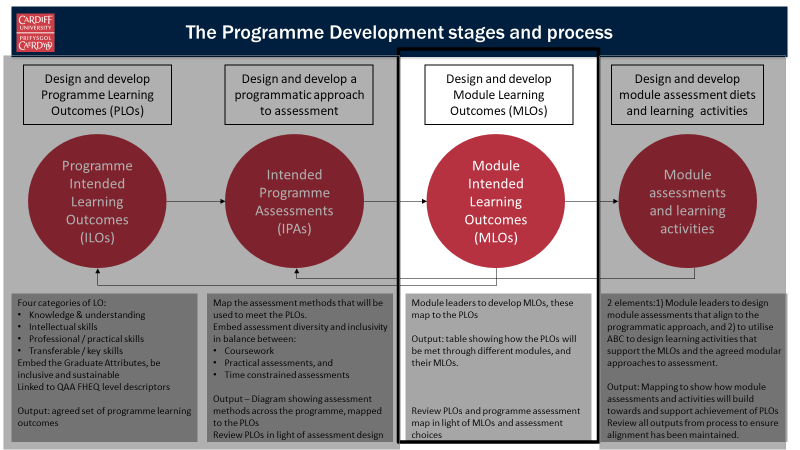
A module represents a ‘self-contained, formally structured unit of study, with a coherent and explicit set of learning outcomes and assessment criteria’ (QAA, 2018). However, each module is just one piece of the programme puzzle. All modules should combine to ensure that across a programme, students are able to achieve the programme learning outcomes. Through a series of modular assessment tasks, students should have demonstrated achievement of the programme outcomes through the intended programme assessments.
Modular Learning Outcomes (MLOs) should be structured to support the Programme Learning Outcomes (PLOs). In other words, MLOs should identify how they support one (or more) of the PLOs.
As a reminder, at Cardiff these PLOs are structured in the following categories:
- Knowledge and Understanding
- Intellectual Skills
- Practical and Professional Skills, and finally,
- Transferable Skills.
What is essential is the ways the modules collectively enable the accumulation of knowledge and skills to meet the programme learning outcomes can be explained and rationalised. This is best done in form of a Programme to Module Learning Outcomes map.
The MLOs should consider the FHEQ Level of study appropriate to the relevant stage of the award: see the reflective prompts section for more guidance. You might notice some of the guidance is similar in the Programme Learning Outcomes and Module Learning Outcomes page – this is because there are many similarities in writing PLOs and MLOs, and in order to cater for a variety of toolkit users, we have provided it on both pages. Typically in a semester-long module, there would be no more than four or five MLOs. The verbs used for these MLOs will inform the Module Learning Activities (see Learning Design section for more on this).
Just as Programme Learning Outcomes are mapped to the graduate attributes, staff should engage in Graduate Attributes Mapping at the module level.
How to write MLOs
It’s not rocket science… or is it?
Some examples of module learning outcomes from our fictional Rocket Science programme can be seen below as initial examples for exploration. Note the increasing level of challenge across the levels.
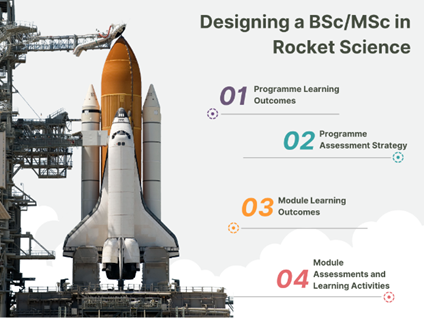
- Level 4 – To discuss the industry of Rocket Science in a report
- Level 5 – To interpret the commercial implications of rocket development
- Level 6 – To select relevant Rocket Science research for development into a business proposal
- Level 7 – To compile research of benefit to the field of Rocket Science
Writing effective MLOs
To ensure that your learning outcomes are student focused, it can be useful to try and put yourself in the student’s shoes and to think about how you might respond to these as a student. Learning outcomes are normally made up of three elements.
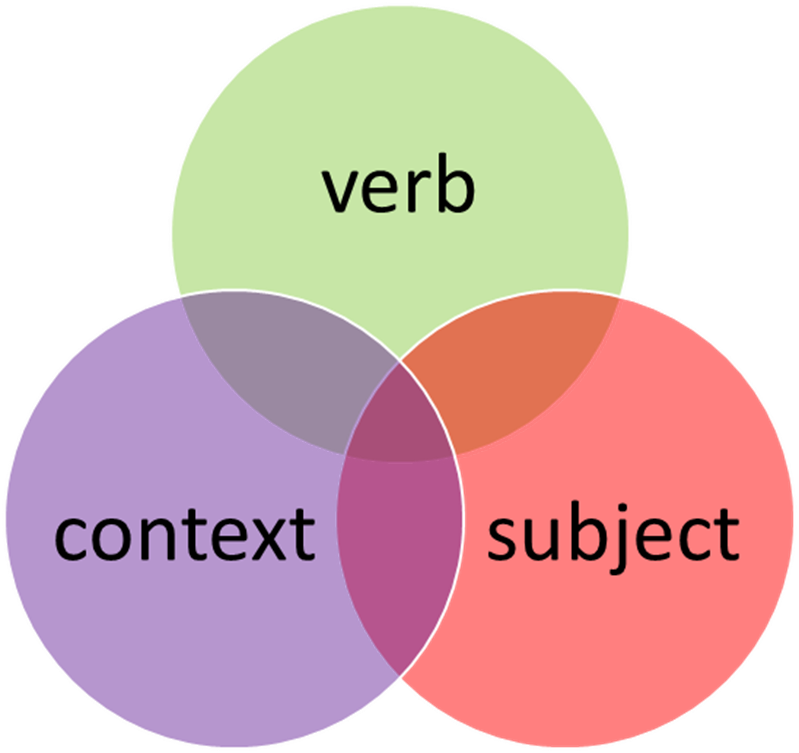
- A verb to define the specific action that students to demonstrate their learning.
- A subject, to specify the subject material you want the learning to cover.
- The context of the learning. While learning outcomes do not need to explicitly refer to particular methods of assessment, they should include an indication of the standard of the performance that will demonstrate that the defined learning has been achieved. It should therefore be clear what a student needs to learn/do to attain that learning outcome.
Let’s see that in practical terms:
- An action that can be verified empirically, by ‘the evidence of your eyes and ears’;
- A subject: the given;
- Performance criteria which contextualises the learning (may be implicit).
Examples:
- Analyse the relationship between the language of satire and literary form by the close examination of a selected number of eighteenth-century texts.
- Compile a research paper which encompasses a wide range of relevant methodologies and resources.
- Demonstrate a critical understanding of the technological aspects of imaging modalities, including the use of pharmacological agents, to assist with the procedures.
- Design and prepare a clear and coherently structured written presentation about the biography of a building or site.
- Demonstrate an in depth knowledge of implementing evidence based risk assessments, risk and crisis management plans, in collaboration with service users and carers and colleagues from inter-professional and interagency organisations.
Intended outcomes should always be assessable, so their wording needs to reflect the skills and behaviours students should be able to demonstrate on successful completion of the programme/module.
Module Learning Outcomes checklist
Sheffield Hallam University (2015) offer a checklist for effective learning outcomes, which we have edited slightly. You can read it below.
Writing better MLOs: An activity
Activity
Fancy Sharpening your MLO writing skills? This practical, accessible and thought-provoking MLO re-writing activity can be completed in the time it takes to finish a cup of tea!
Different Levels of Study
The verb in the intended learning outcome becomes the common link by which alignment can be achieved between the intended learning outcome, the teaching/learning activities and the assessment tasks. Some ntended learning outcomes would require low level verbs such as “describe”, “enumerate”, “list”; others middle level, such as “explain”, “apply to familiar domains”, “solve standard problems”, while at an advanced level appropriate verbs would include “hypothesize”, “reflect”, “apply to unseen domains or problems”.
The following verb list document is likely to be invaluable in setting verbs at the correct level for your programme.
Activity
Here is another activity for you to enjoy – this time gather some helpful verbs categorised by learning level and solidify your understanding of learning domains.
MLOs and Constructive Alignment
Constructive alignment (CA) is a form of outcomes-based education that specifies how teaching and assessment may be aligned to the intended learning outcomes, thus operationalising Shuell’s description of effective teaching (Biggs and Tang 2011).
In order to achieve contstructive alignment, we need to:
✅ Describe the intended learning outcomes (ILOs) in the form of a verb that denotes how the content or topics are to be dealt with and in what context.
✅ Create a learning environment using teaching/learning activities (TLAs) that address that verb and therefore are more likely to bring about the intended outcome.
✅ Use assessment tasks (ATs) that also contain that verb, enabling one to judge how well students have achieved the ILOs based on pre-set criteria or rubrics.
✅ Transform these judgements into standard grading criteria using rubrics.
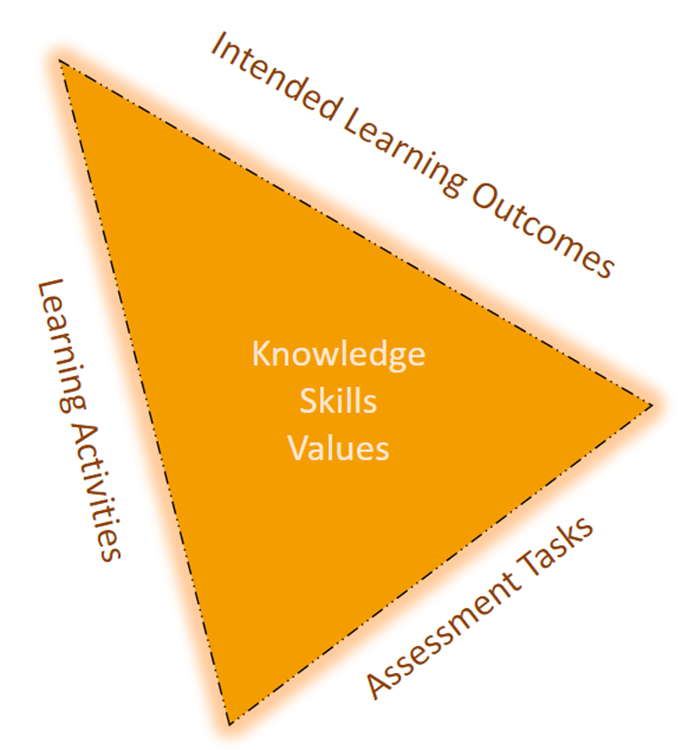
Constructive alignment: An activity
A brief matching activity is provided here for you to become more familiar with the words of Biggs (1996) on constructive alignment. Another coffee break challenge!
Below are some prompts when attempting to achieve constructive alignment during the learning outcome writing process.
Deeper dive
Holistic template map
This is how far we've got along in filling in our planning map. As a reminder, this is not a Quality Assurance document, just a tool for planning.
If you'd find a blank one helpful for planning, click here.
|
In section 1, we covered: |
In section 2 we covered: |
In this section we've filled this in: |
In the next section, we’ll fill this in: |
|||
|
Learning outcomes category |
Example Programme Learning Outcomes |
Primary Graduate Attributes |
Intended programmatic assessment methods |
Potential Module Learning Outcomes |
Potential Modular assessments |
Potential Module Graduate Attributes addressed |
|
Knowledge and Understanding |
LO 1 - Understand and apply core theories, concepts, and techniques at the forefront of Rocket Science. |
Independent and Critical Thinking |
Exam Essay
|
Level 4 – to explain the basic concepts of gravity and space |
|
|
|
Level 5 – to examine the history of space travel |
|
|
||||
|
Level 6 – to critically evaluate different rocket science techniques in a range of given scenarios |
|
|
||||
|
Level 7 - to apply appropriate Rocket Science theory to C21 grand challenges |
|
|
||||
|
LO 2 - Apply basic and translational Rocket Science research in a range of professional settings, relating to human space flight. |
Innovative, Enterprising and Commercial Awareness
|
Report |
Level 4 – to discuss the industry of Rocket Science |
|
|
|
|
Level 5 – to interpret the commercial implications of rocket development |
|
|
||||
|
Level 6 - to select relevant Rocket Science research for development into a business proposal |
|
|
||||
|
Level 7 – to compile research of benefit to the field of Rocket Science |
|
|
||||
|
Intellectual Skills |
LO 3 - Ability to select and apply appropriate mathematical techniques to solve problems in rocketry. |
Independent and Critical Thinking |
Exam Written coursework |
Level 4 – to understand the basics of mathematics in Rocket Science |
|
|
|
Level 5 – to apply mathematical solutions to given problems |
|
|
||||
|
Level 6 – to practice mathematical approaches taken in the space industry |
|
|
||||
|
Level 7 - to construct mathematical solutions using emerging technology |
|
|
||||
|
LO 4 Design and implement a range of experiments relating to the development of human space flight. |
Ethical, Social and Environmental Awareness |
Practical experiment |
Level 4 – to demonstrate basic skills |
|
|
|
|
Level 5 – to assess the theory of gravity |
|
|
||||
|
Level 6 – to perform relevant procedures required for space flight in a prototype situation |
|
|
||||
|
Level 7 – to operate specialist technology relating to the development of human space flight |
|
|
||||
|
Practical and professional skills |
LO 5 Work effectively within a range of interdisciplinary research teams. |
Collaborative
|
Group Project |
Level 4 – to review group dynamics |
|
|
|
Level 5 – to communicate in a multidisciplinary team |
|
|
||||
|
Level 6 – to initiate a team approach to solving a grand challenge |
|
|
||||
|
Level 7 - to create solutions to a grand challenge, working with local communities |
|
|
||||
|
LO 6 – Present scientific data relating to the construction of rockets in a clear and professional manner. |
Effective Communicators |
Presentation |
Level 4 – to summarise Rocket Science basics to a familiar audience |
|
|
|
|
Level 5– to interpret complex ideas for presentation to a non-science audience |
|
|
||||
|
Level 6 – to synthesize the basics of Rocket Science |
|
|
||||
|
Level 7 - to translate Rocket Science construction proposals to policy |
|
|
||||
|
Transferable skills |
LO 7 Exercise initiative and personal responsibility within a range of professional contexts. |
Reflection and resilience |
Portfolio |
Level 4 – to identify your place in the Rocket Science profession |
|
|
|
Level 5 – to reflect on being a Rocket Science professional |
|
|
||||
|
Level 6 – to demonstrate initiative in a professional environment |
|
|
||||
|
Level 7 – to formulate a clear understanding of how your professional development has informed your practice |
|
|
||||
|
LO 8 Select and utilise appropriate research methods and resources in order to prepare a research project of your choosing. |
Ethical, Social and Environmental Awareness |
Research project |
Level 4 – to locate appropriate resources for use in preparation of a research project |
|
|
|
|
Level 5 – to compare and contrast different research methods in order to select the best approach |
|
|
||||
|
Level 6 – to defend your chosen research methods |
|
|
||||
|
Level 7 – to compile a research paper which encompasses a wide range of relevant methodology and resources |
|
|
||||
Vascular approach to writing MLOs
The following infographic offers information on the differences and similarities between Programme and Module Learning Outcomes. VASCULAR refers to a progressive approach to writing Learning Outcomes proposed by Sally Brown: feel free to read this in order to develop your understanding further and contact the CLTA if you'd like to know more.
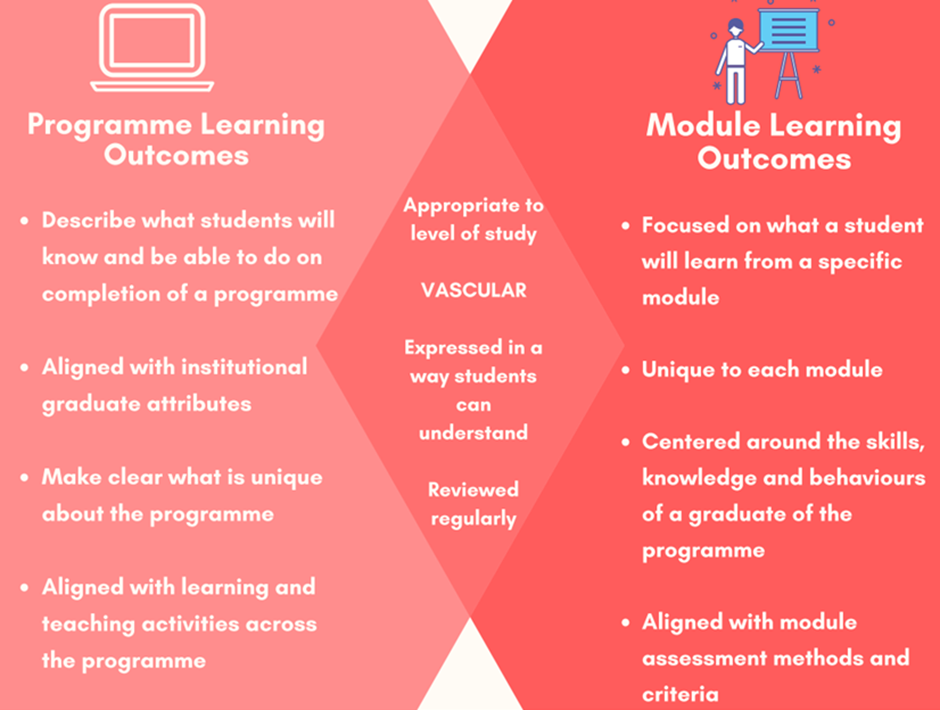
Levels, SOLO taxonomy and challenges of Bloom's Taxonomy
Why do levels matter so much when writing Module Learning Outcomes?
As well as guiding students as to what they need to demonstrate through assessment, a module’s learning outcomes also provide an important indication of the academic standards of that module. While the actual academic standards, as an ‘output’ measure, will (and can) only be demonstrated in the work students produce, validation panels, external examiners (and others) verify the ‘quality standards’, the input measures that include internal documents such as module descriptions. As such, module descriptions need to map onto the level descriptors that operate across UK higher education; these being set out in the QAA Framework for Higher Education Qualifications (FHEQ). A lack of alignment with these frameworks, particularly at the validation stage, often causes further work and can delay a module’s introduction. Getting it right first time will help avoid such delays.
Developed originally in the 1950s and extensively revised and redeveloped since then, Bloom’s taxonomy is often one of the first points of reference that staff use when developing learning outcomes; the hierarchical model it is based on helping classify a module’s complexity and specificity.
However, and although it provides a useful framework, a number of issues can and do arise from its use. These include the lack of a shared understanding of the descriptors that arise from its use; terms like ‘critical analysis’ not having a definable and easily shared meaning; leading them open to different interpretation. Using Bloom’s also does mean that you can simply progress up the hierarchy in sequence.
You don’t have to restrict yourself to the lower levels in the early part of a module or programme, or to the higher levels in later stages. For example, you can still introduce new concepts in a Level 6 module, which will require your students to ‘Understand’ before they ‘synthesise’ and ‘evaluate’.
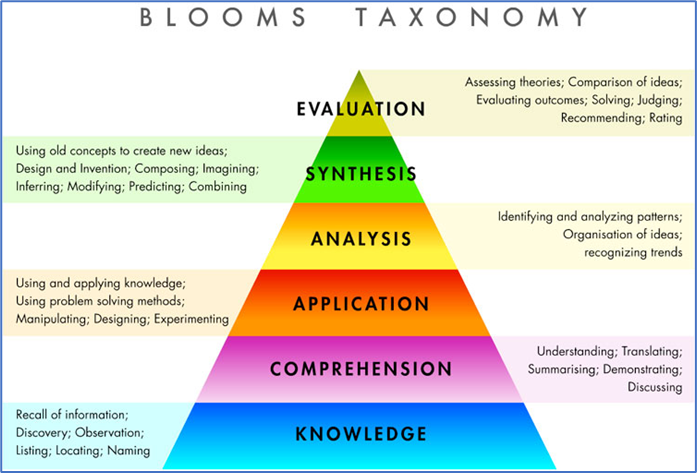
Collis and Biggs (1982) offer a complementary taxonomy for classifying learning that focuses on how connected and integrated students' use of information is. This may be a helpful tool to work with alongside Bloom's taxonomy, which is commonly used.
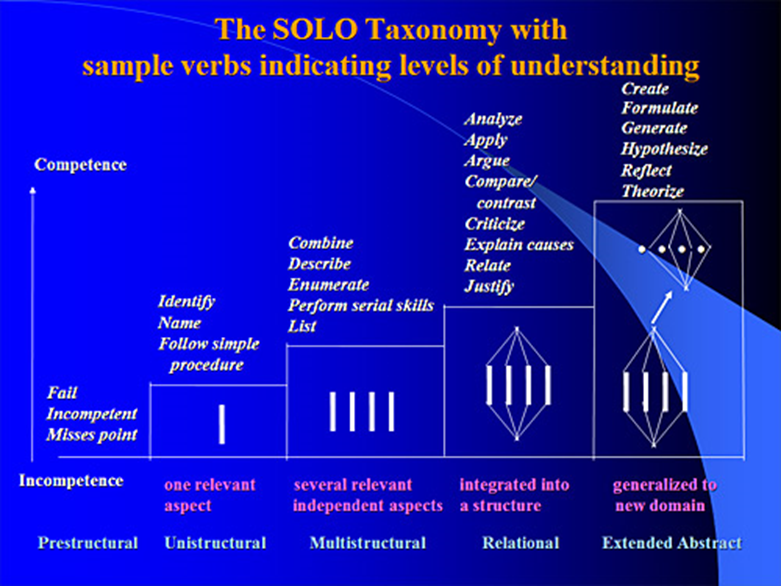
This resource by Education in Chemistry explores the relationship between increasingly sophisticated ways of knowing and the skills and assessments that aid students in evidencing these understandings.
Share your feedback
Next steps
You are on page 3 of 4 of the 4-stage process for Programme Development.
The next page is:
4) Module Assessment
❗ It is strongly recommended if you are designing a new programme or undergoing revalidation that you explore the following pages as you build up your Quality documentation. They are in a fixed order:
Or you could return to Programme Development and visit the other pages another time.